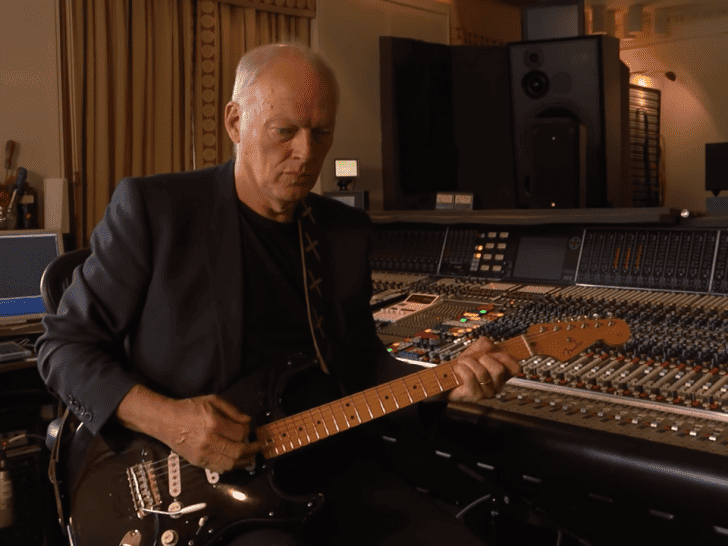If you go around asking every other guitarist you know who their biggest influences are, a lot of them will end up mentioning David Gilmour at some point.
The legendary guitarist who rose to world fame with the timeless band Pink Floyd has changed the way many of us look at the guitar, and inspired thousands to pick it up, myself included.
His guitar tone is a sum of many elements that take time to comprehend and master. He has a very melodic and musically sensible approach to guitar lines, and he absolutely favors emotive playing over shredding and other flashy techniques.
Gilmour is known for using a lot of string bending, whammy bar vibrato, and other expressive resources, as well as contrasting clean sounds with saturated tones fluently.
While emulating someone’s playing technique can be very challenging, a great step to getting closer to their overall tone is setting our amplifier and effect pedals properly.
In this David Gilmour Amp Settings Guide, I am going to walk you through everything you can’t overlook in your pursuit of a classic, Floyd-esque tone.

Bottom Line Up Front
David Gilmour’s guitar tones come in various shapes and sizes. You can hear him playing crystal clear sounds with a lush modulation effect as well as a highly saturated lead sound that could cut through any mix.
Regardless of the sound he’s crafting, he generally resorts to a Fender Stratocaster with single-coil pickups and a powerful, pedal-friendly clean amp such as a 100W Hiwatt head or a Fender Twin Reverb. He’s used countless types of overdrives, fuzz pedals, delays, and a plethora of modulation effects such as phaser, flanger, chorus, vibe, among others.
When dialing in your amp for a Gilmour-inspired tone, I recommend starting with the Bass around 5, Middle at 7, and the Treble at 5. The Gain should be low, around 3, if you want to get your dirty tones with pedals.
At this point, you should experiment with your guitar’s pickups, with the EQ available on the pedals you have engaged, and adjust accordingly to the exact tone you’re going for.
David Gilmour Amplifier Settings: A Starting Point for a Huge Tone
The following settings suggestion is meant for you to prepare a clean amp that you will ideally use with a guitar that features single coil pickups, as well as pedals to get your overdrive and distortion tones.
Start with the following settings:
- Volume: 5
- Gain: 3
- Treble: 5
- Mids: 7
- Bass: 5
These settings are meant to give you a tone with enough body and weight to sustain clean sounds with ease, without any troublesome bass frequencies to muddy up the mix.
The reason why I suggested the volume to be at 5 is because that will make the amp interact with overdrives and fuzz pedals more musically, enhancing your tone.
If you can’t rely on pedals for your dirty tones, you will obviously need to increase the Gain considerably when you need to go from clean to distortion.
If you’re using a Stratocaster, you should know that they tend to sound pretty bright, and that is why I only suggested keeping the Treble at 5.
These settings are only a starting point, so you should adjust any frequencies that you find unpleasant while testing out your rig. If it sounds muddy decrease the bass, and if it sounds too shrill, decrease the treble.
Although nailing the amplifier’s settings is a huge step in the right direction, there are many things to take into account when we’re trying to get to the exact sound we have in our heads. Let’s investigate a bit more about that.
What Affects and Defines an Electric Guitar’s Tone?

What exactly makes a great guitar tone? Guitarists like to talk about how they achieve their dream sound, as well as investigate what their idols use in order to replicate their setup as closely as they can.
It is important to know how each component of your rig affects your overall tone, and how you can tweak them to get the most out of everything. Generally speaking, you could say that an electric guitar’s sound is affected by the following factors:
- Guitar Body Type: Solid Body, Semi-hollow Body, Hollow Body
- Pickup Choice: Humbuckers, Single-coils, P90’s, Goldfoils, etc
- Amplifier Type: Solid State, Tube Amp, Plugin/Emulator
- Amplifier’s Settings: Volume, Gain, Bass, Middle, Treble, Presence
- Effect Pedals: Overdrive, Distortion, Fuzz, Modulation, Time-based Effects, etc
When you first realize how many things you must take into account to finally grasp the sound you have in your head, it can become a bit overwhelming, but experimenting while chasing your dream tone is one of the most fun parts of playing the guitar for me, it never ends!
Also, having the ability to quickly assemble a guitar rig with a certain sound in mind is an excellent skill to have, and it will give you an edge in any project such as a cover band, studio sessions, cruise ship gigs, and much more.
Lastly, we couldn’t talk about what affects a guitar’s tone without mentioning the most important part of the equation: you! The player ultimately shapes the sound the most through the different techniques that can be used, his articulation, feel, and time, among other things.
When you try to emulate a guitarist’s sound, you really have to listen to them carefully, watch live footage of them, and see how they approach certain techniques like string bending, vibrato, legato, and incorporate as much of that as you can into your own playing.
David Gilmour’s Tone: Lots of Gear and Moving Parts
As a guitarist, when you start exploring the kind of equipment that your musical heroes like to use in the studio and during live performances, you realize that some of them like to keep it very simple and straightforward, while others seem to enjoy having complex rigs.
For example, if you take a look at what Derek Trucks uses, you’ll find that he goes straight from the guitar to his amplifier, which has built-in reverb. Other guitarists will have something like a boost that they engage for solos and maybe a wah pedal or a delay.
David Gilmour is in a totally different league though – he is known for experimenting with dozens of effects, combining them in different ways, always pushing the boundaries of what was possible to achieve with the gear he had available, both live and in the studio.
If you want to nail his sound, aside from the guitar and amplifier, you will have to do your homework when it comes to assembling a pedalboard. Fortunately, I am here to help you with all of these! Check below for a comprehensive explanation of his main guitars, amplifiers, and effect pedals.
David Gilmour’s Guitars
David has been an avid user of the Fender Stratocaster since his early days, and he used it throughout his time with Pink Floyd, as well as in his solo career. His most famous guitar of this kind is “The Black Strat”, a heavily modded 1969 Fender Strat.
He purchased it from Manny’s Music in New York City in 1970 and you can hear it on every Floyd record between that year and 1983, aside from all the live footage that can be found everywhere.
This guitar features Seymour Duncan SSL-1 single-coil pickups, a mod that allows for the neck pickup to be engaged while playing on the bridge or middle position, and many other mods that were done over the years. His preferred string gauge for Stratocasters is 010-012-016-028-038-048, usually GHS Boomer strings.
In 2019, David Gilmour auctioned off a significant part of his guitar collection, and The Black Strat was among those he decided he didn’t want to keep anymore.
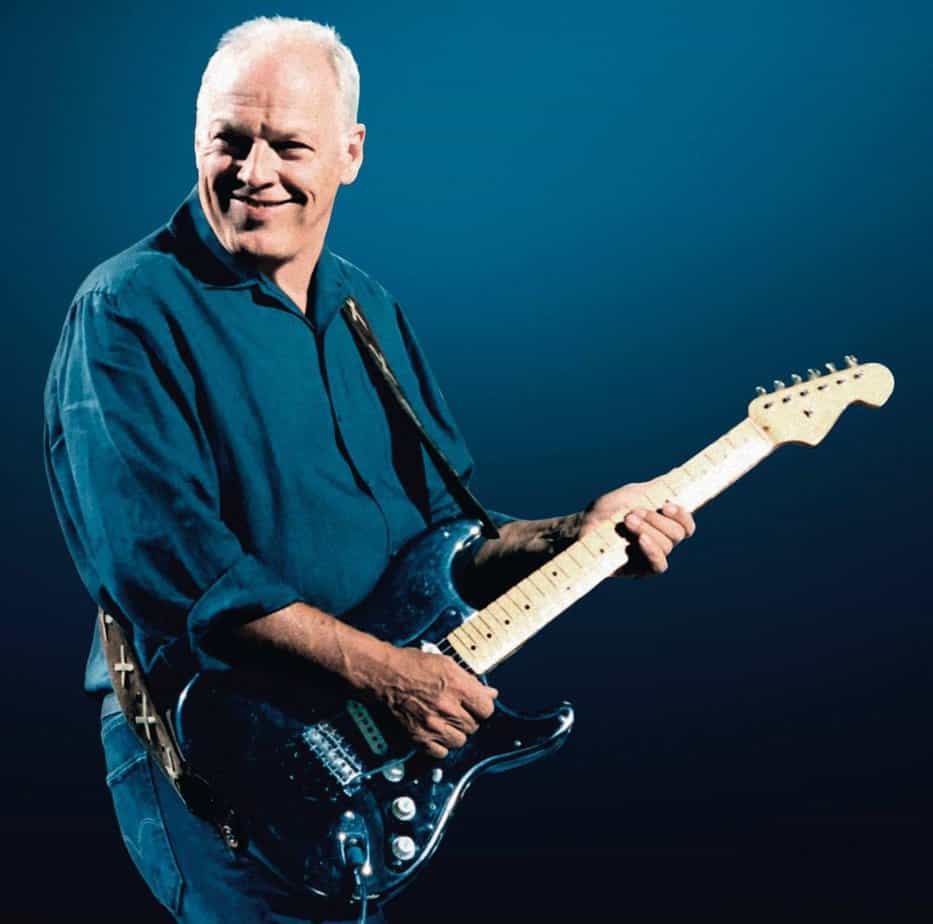
Aside from this iconic instrument, Gilmour has also played numerous other Stratocasters such as his Vintage Series ’57 with EMG SA pickups. This Candy Apple Red Strat features a maple neck and active pickups that were designed to have less noise than the regular single coils it originally had.
Apart from Stratocasters, David Gilmour has been seen playing guitars such as a 1955 Gibson Les Paul Goldtop and a 1955 Fender Esquire (similar to a Telecaster).

David Gilmour’s Amplifiers
As any gearhead would, Gilmour has experimented with more amps in the studio than you and I probably tried since we’ve started playing the guitar. However, he generally tends to go with amplifiers that are loud and have a lot of clean headroom, so he can get sparkly clean sounds as well as incredibly saturated, silky smooth lead tones.
His most popular amp choice is his Hiwatt DR103 Custom Head, which he pairs with WEM Super Starfinder 200 cabs that feature 12″ Fane Crescendo speakers. Aside from this, he often uses Fender Twin Reverb heads, which is understandable due to their sheer power and ability to remain clean even when pushed very hard.

David Gilmour’s Effect Pedals
David Gilmour is undoubtedly a player who likes to experiment with different pedals, as well as tweaking them in nearly infinite different ways to obtain the legendary sounds we love to listen to on his records.
Since Gilmour prefers to get his dirty tones from pedals rather than from his amplifier, he’s used several overdrive and fuzz pedals. He’s also known for ambient, spatial sounds that he crafts by using time-based effects like delay and reverb, as well as a myriad of modulation effects such as chorus, flanger, phaser, vibe, among others.
Although his collection and preferences over the years deserve their own guide, there are a few staples that can’t be overlooked when discussing his pedal tastes.
- Electro Harmonix Big Muff Pi – a very saturated fuzz pedal that David enjoys using for many of his lead tones.
- Dallas Arbiter Fuzz Face – a more vintage-sounding fuzz with a very pronounced bottom end. It usually responds very well to the guitar’s volume knob, allowing for a wide range of saturation without touching any other pedals.
- BK Butler Tube Driver – an acclaimed overdrive pedal that produces a very organic, harmonically rich, and musical tone. It is powered by a vacuum tube and it can go anywhere from a clean boost to distortion territory. Gilmour has used it on countless records and live performances.
- Binson Echorec II – á magical delay unit that many guitarists experimented with during the 60s and the 70s. It is powered by 6 12AX7 tubes, it is fragile and it has a considerable size, which is why it is mostly used as a studio tool.
- Univox Uni-Vibe – originally intended to mimic a rotary speaker like a Leslie, the Uni-Vibe ended up bringing a new sound to the table. It was made popular by Jimi Hendrix, and Gilmour also appreciated it notably.
- MXR Phase 90 – one of the most widely used modulation effects. It produces a lush swirl that envelops your entire sound. Fortunately, it couldn’t be simpler to operate, with a single “Rate” knob that controls the speed of the oscillation effect.
- MXR Dyna Comp – the Dyna Comp is one of the most well-known compressors in the guitar ecosystem, and it has been Gilmour’s number-one choice for many years. Although its two-knob design makes tweaking your sound easy, it still manages to be quite versatile.
- Electro Harmonix Electric Mistress – the Electric Mistress is Electro Harmonix’s most popular flanger pedal, and David used it extensively between 1977 and 1983, the period that many consider to be Pink Floyd’s peak.
You can still find some of these pedals in most music shops, such as the Phase 90 and the Dyna Comp. Others are not as easy to find, and their prices are also much higher. Fortunately, today’s guitar industry is at a point where even budget options can sound very decent in the right hands.
Modern-Day Suggestions to Replicate David Gilmour’s Tone without Filing for Bankruptcy
Fortunately, nowadays there are many guitars, amplifiers, and pedals that do an amazing job while maintaining a moderate price tag.
Not all of us want to spend thousands of dollars on vintage amps and expensive Custom Shop guitars, but it is possible to get extremely close to David Gilmour’s base sound without breaking the bank. Below, you will find a few of my favorite suggestions to get you started.
The Guitars: Single-Coil Nation
Guitar-wise, the most logical choice is to go with a Stratocaster that features 3 single coils and a whammy bar, at the very least. Here are three excellent suggestions spanning three different budgets. I would be happy playing any of these in a Floyd-inspired group.
Squier Classic Vibe ’50s Stratocaster

Every guitar in the Classic Vibe series offers amazing value for a very moderate price. This model features a trio of Fender Designed Alnico Single Coils, a C-shaped maple neck with maple fretboard, and a vintage-style synchronized tremolo.
All the ingredients for cooking some David Gilmour tones are present in a visually appealing instrument for under $500, so this would be my number-one choice for anyone who doesn’t want to spend a lot of money.
Fender Player Stratocaster

The Fender Player Stratocaster is a cut above the Squier we just discussed. This is a Mexican-made Fender that manages to stay well below the $1000 mark without compromising on sound or feel.
A couple of small upgrades and a good setup will take you a very long way with this guitar, and if later on you want to invest a little more, swap the pickups for something that you would find on a more expensive Stratocaster.
It is comfortable to play, and it does just as well with spanky clean sounds as it does with full-blown fuzzed-out tones that could bring the house down.
Fender American Performer Stratocaster
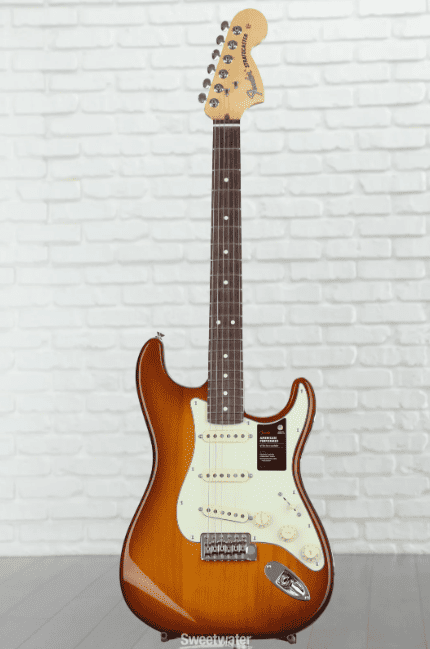
If you don’t take the Custom Shop into account, American Stratocasters are the best that Fender has to offer to anyone looking for the quintessential guitar design that has been seen and heard around the world for decades.
The Fender American Performer Stratocaster has everything you’d expect from a high-end guitar and a few surprises up its sleeve. For instance, you’ll find what many people refer to as the “Gilmour Mod”, which adds the neck pickup to any other position by using the push/pull neck/middle tone knob.
If you pull the trigger on one of these, you will soon find out why so many guitarists have fallen in love with the Fender Stratocaster.
The Amplifiers: Clean Pedal Platforms Club
If you’re pursuing David Gilmour’s tones, I’d advise you to look for an amp that has a great clean sound, and that plays well with effect pedals of most kinds.
Fender amps are generally good at these, and they cost way less than the Hiwatts that Mr. Gilmour is so fond of. Take a look at some of my favorite suggestions below.
Fender Blues Junior IV Lacquered Tweed

The Blues Junior is a great amp for people who can’t crank their amplifiers all the time, just like me in my apartment. At 15W of power, you can still get the tubes working properly without shaking the foundations of the entire building. Your neighbors will also thank you!
The Lacquered Tweed version has a superior-sounding reverb in comparison to the Standard version, which is why I’d recommend it.
The clean tone is very decent for an amp under $1000, and it handles overdrives and fuzz pedals beautifully if you play at a moderate volume.
Fender Tone Master Twin Reverb
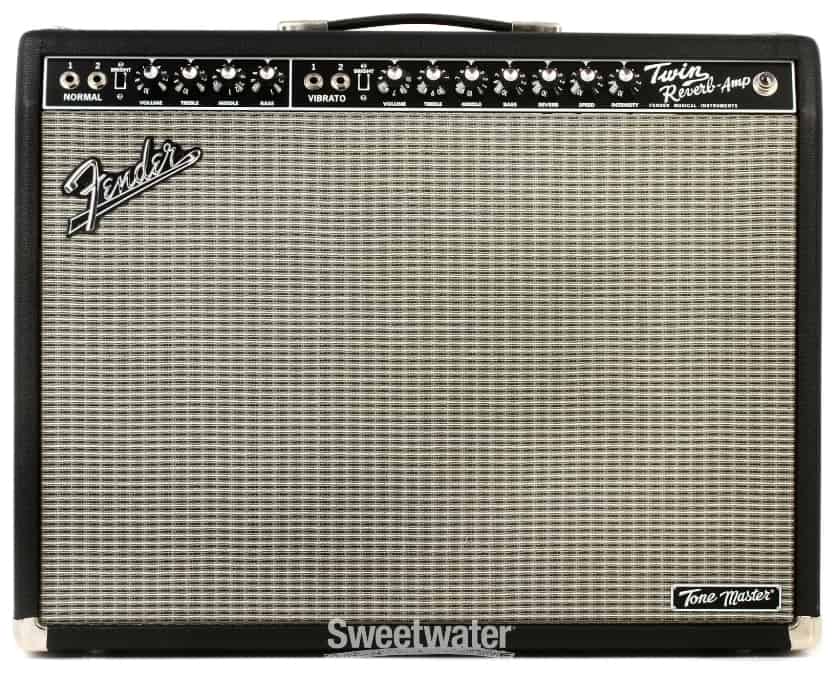
I’ve included the Tone Master Twin Reverb so that you can have a solid-state option as well. Although tube amps sound great, they are heavier and require more frequent maintenance, so it is understandable if someone would rather get a more reliable alternative.
It still sounds amazing, handles pedals like a champ and has a marvelous reverb that will eliminate any need for a pedal. In terms of volume, you will never have to worry, as 200W of power should be more than enough for any situation.
Fender ’68 Custom Pro Reverb

Every amp in the ’68 Custom Series is a delight to play. Even though I’m suggesting the 40W Pro Reverb, the 22W Deluxe Reverb or a higher-powered model would be just as great.
The clean sound is the best that Fender has to offer, the reverb is to die for, and they interact musically with pedals, making them a perfect option to get closer to David Gilmour’s tone.
The Effects: Space, Dynamics, and Dreamy Modulation
Planning a Gilmour-inspired pedalboard is where things can get a bit crazy, as there is so much to consider, and so many options that could make it into the final build. The following suggestions can get you started, but I’d experiment with as many options as possible.
Electro Harmonix Green Russian Big Muff

There are many versions of the Big Muff, but I would recommend this one due to its small enclosure, and because it is a reissue of one of the most popular editions of this pedal back in the 70s.
Use it to get silky smooth lead tones, as you would use a distortion pedal.
Boss BD-2 Blues Driver

Since the Big Muff does not clean up very well and tends to sound saturated and compressed, it is useful to have an overdrive pedal that has a more tame character. The Blues Driver has been around for decades and it fulfils this role very well for a low price.
Catalinbread Echorec

The Echorec is heavily inspired by the famous Binson Echorec that David Gilmour and many other guitar legends have used throughout their careers.
It is a joy to play with the 12 different delay algorithms found in this pedal, and you can recreate many Floyd tones with it.
MXR Phase 90 (Script Logo)
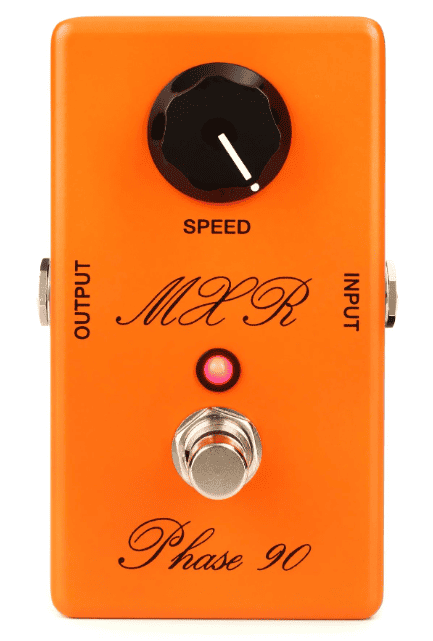
The Phase 90 is an inexpensive but iconic modulation pedal that has been seen worldwide for decades. Due to its character, you can use it in songs where David would use a vibe pedal, and it still sits in very nicely.
Use it for songs like Breathe or Us & Them.
MXR M291 Dyna Comp Mini

A compressor can come in handy in several different contexts. You might want to even out the peaks on a strumming part, add volume and sustain to a lead tone, but you don’t want to add a lot of noise to your signal.
The MXR Dyna Comp Mini is a great choice for this, and it is similar to the Dyna Comp that Gilmour has used for years.
FAQs: Frequently Asked Questions about David Gilmour’s Amp Settings and Tone
FAQs: Frequently Asked Questions about David Gilmour’s Amp Settings and Tone
Question: What guitar amplifier settings would be a good starting point to get a guitar tone similar to David Gilmour’s?
Answer: The perfect settings depend on the guitar, the amp, and the room where you’re playing, but these should be a good starting point: Gain at 3, Treble at 5, Middle at 7, Bass at 5, and Volume to taste. This suggestion works best on a Stratocaster and a clean Fender-style amp.
Question: What guitar type would be a good choice when trying to emulate David Gilmour’s sound?
Answer: Even though David Gilmour can be seen playing various types of guitars, his favorite kind is undoubtedly the Fender Stratocaster. Logically, that is what you should aim for when pursuing a Gilmour-influenced tone. If the American models are above your current budget, look into Mexican-made Fenders, or other brands such as Squier, Ibanez, G&L, or Yamaha. The main features you should look for are single coil pickups (preferably SSS configuration, not HSS), and a whammy bar (tremolo).
Question: Which effects are mandatory to have when you want to sound close to David Gilmour on Pink Floyd’s records?
Answer: David Gilmour has used a wide variety of effects throughout his career. Assuming that your amplifier already has reverb, I would buy an overdrive, a fuzz, a delay, and some kind of modulation such as a vibe, phaser, or flanger pedal.
If it is within the budget, other effects would come in handy, like a compressor or a boost pedal. It is important to know what kind of sound you are going for since Gilmour himself has used several types of fuzz and overdrive pedals depending on the album he was recording.
Closing Considerations about David Gilmour’s Amp Settings and Sound
By now, you can already tell that nailing David Gilmour’s tone isn’t realistically achievable by dialing in the perfect amp settings, but they are also extremely important to get them right to make the most out of every part of your rig.
David is known for using Stratocasters paired with high-headroom amplifiers such as the Hiwatt DR103 or the Fender Twin Reverb.
His dirty tones generally come from overdrive and fuzz pedals, and he is very fond of using delay and modulation effects to create a bigger sense of space and texture in his compositions.
When dialing in your amp, try starting with the Bass at 5, Middle at 7, and the Treble at 5. Set the Gain around 3/4 and Volume depending on the room. These settings are meant for a clean amp so that you can use pedals to get dirty rhythm and lead tones.
As I always say, the most important part of the entire process is listening to everything you can from the artist you’re trying to emulate, and slowly tweak your gear.
Don’t forget to pay attention to their articulation and to how they use techniques such as vibrato and string bending, as these are important aspects of a guitar player’s style.
- My Supro Black Magick Reverb Head + 2×12 Cab Review – A Trip to the 70’s Rock n’ Roll Spirit - April 17, 2024
- Everlong Amp Settings Guide - January 29, 2024
- Takamine vs Taylor Brand Comparison - January 19, 2024

